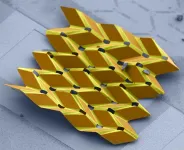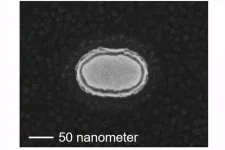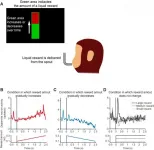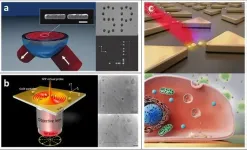Parkinson's disease: When molecular guardians need to be protected
2021-03-19
(Press-News.org) Parkinson's disease is the second most common, age-related, neurodegenerative disease: In Germany alone, about 300,000 people are affected and experience sometimes major limitations to their quality of life. Although Parkinson's is so widespread, there is still no treatment that targets the cause of the disease and can stop it in its tracks.
However, current research provides new hope: A research team at the University of Konstanz led by Professor Marcus Groettrup describes a new approach for developing future treatments for Parkinson's. The biologists demonstrated that the ubiquitin-like protein FAT10 inhibits the molecular defence mechanisms protecting the brain from Parkinson's disease. The biological mechanism is tricky: FAT10 causes processes in our own body that degrade the body's molecular "guardians" against Parkinson's disease (the enzyme Parkin). Instead of getting rid of damaged mitochondria in brain cells, Parkin is itself disposed of by the body. The research results were published in the scientific journal Cell Reports on 16 March 2021.
Damaged power plants of the cells
Parkinson's disease develops as a result of nerve cells dying off in the mesencephalon (midbrain). This is caused by faulty disposal of damaged mitochondria, the cells' "power plants". When damaged mitochondria are not disposed of by the body, oxygen radicals develop in the brain. These, in turn, damage the nerve cells, causing them to die.
So that the body can dispose of mitochondria, they have to be marked by a signalling substance. This can be compared with labelling them as "broken - please throw away". The enzyme Parkin is responsible for labelling damaged mitochondria. The molecular label it gives them contains the protein ubiquitin.
Wrongly labelled
This is where the protein FAT10 comes into play. FAT10 has a very similar structure and function to ubiquitin. It is also a signalling substance that labels other molecules for disposal. Unfortunately, FAT10 is the wrong label for mitochondria. FAT10 not only labels the damaged mitochondria, but also the enzyme Parkin for the body to dispose of.
To use a picture: It would be like labelling the cell's own guardians for disposal - the very ones that otherwise label damaged mitochondria for disposal. The body then does what the labels tell it to do. The more guardians are disposed of, the fewer damaged mitochondria can be correctly labelled for disposal. What happens as a result? The body's defence processes do not dispose of the damaged mitochondria - and the brain cells themselves are damaged over time.
"We hope this discovery provides a new approach to developing an effective treatment for Parkinson's. An inhibitor for FAT10 could possibly be used to limit the disposal of Parkin and ensure that damaged mitochondria are disposed of correctly", says Marcus Groettrup.
INFORMATION:
The research was completed with the key participation of Nicola Roverato, lead author and doctoral researcher in the research team led by Marcus Groettrup. The work was funded in the context of the Collaborative Research Centre "Chemical and Biological Principles of Cellular Proteostasis" (SFB 969).
Key facts:
Original publication: Roverato, N., Sailer, C., Catone, N., Aichem, A., Stengel, F., and Groettrup, M. (2021). Parkin is an E3 ligase for the ubiquitin-like modifier FAT10 that inhibits Parkin activation and mitophagy Cell Rep. 34(11):108857. doi: 10.1016/j.celrep.2021.108857.
Headed by: Professor Marcus Groettrup, professor of immunology at the University of Konstanz
Research on the role of the ubiquitin-like protein FAT10 in the development of Parkinson's disease
Funded by the German Research Foundation (DFG) in the context of the Collaborative Research Centre "Chemical and Biological Principles of Cellular Proteostasis" (SFB 969)
Note to editors:
You can download a photo here:
https://cms.uni-konstanz.de/fileadmin/pi/fileserver/2021/parkinson-erkrankung.jpg
Caption: Fluorescence microscopy image of tinted mitochondria
Copyright: Nicola Roverato, University of Konstanz
Contact:
University of Konstanz
Communications and Marketing
Phone: + 49 7531 88-3603
Email: kum@uni-konstanz.de
- uni.kn/en
[Attachments] See images for this press release:
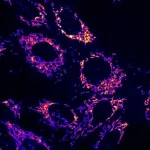
ELSE PRESS RELEASES FROM THIS DATE:
2021-03-19
Boston, Mass. - In a paper published in the Journal of General Internal Medicine, physician-researchers at Beth Israel Deaconess Medical Center (BIDMC) assessed the relative impact of COVID-19 on patients hospitalized with the viral infection in March and April 2020, versus patients hospitalized with influenza during the last five flu seasons at the medical center. Overall, the team demonstrated that COVID-19 cases resulted in significantly more weekly hospitalizations, more use of mechanical ventilation and higher mortality rates than influenza.
COVID-19 and influenza are both contagious respiratory viral diseases that can lead to pneumonia and acute respiratory failure in severe cases. However, detailed comparison of the epidemiology and clinical characteristics of COVID-19 ...
2021-03-19
Researchers at Aalto University and the Niilo Mäki Institute have used neuroimaging to pinpoint where the brain activates - or doesn't activate - among children identified as having a high risk of dyslexia. Magnetoencephalography (MEG) has rarely been used to study the reading disorder in children.
The brain study was carried out at Aalto University by measuring brain activity with MEG, which measures the weak magnetic fields arising from electrical activity in the brain, over a period of two days. Earlier studies have shown that difficulties in processing sounds may be partly responsible for dyslexia, and that these challenges may relate to the left auditory cortex which processes language.
During the study, the children listened to nonsensical ...
2021-03-19
At the start of Neurodiversity Celebration Week, new research from Cranfield University demonstrates the importance of organisations becoming more inclusive employers when it comes to neurodiversity.
It has been estimated that one in seven of the population of the UK is neurodiverse. However, according to research by the Institute of Leadership and Management, only half of managers would employ a neurodiverse person.
Last week, in an interview with The Times, The Second Sea Lord Vice Admiral Nick Hine, revealed that ten years ago he was diagnosed with autism.
Speaking to The Times, the Vice Admiral, said: ""The world is made for neuro-typical people by neuro-typical people, and therefore it's not surprising that people who are not neuro-typical have a ...
2021-03-19
RESEARCH TRIANGLE PARK, N.C. -- Army-funded researchers created nanosized robots that could enable locomotion, novel metamaterial design and high-fidelity sensors.
Cornell University researchers created micron-sized shape memory actuators that fold themselves into 3D configurations and allow atomically thin 2D materials with just a quick jolt of voltage. Once the material is bent, it holds its shape, even after the voltage is removed.
To demonstrate the technology, the team created what is potentially the world's smallest self-folding origami bird.
"The research team is pushing the boundary of how quickly and precisely we can control motion at the micro- and even nano-scales," said Dr. Dean Culver, program manager for Complex Dynamics and Systems at Army Research Office, ...
2021-03-19
Infection with severe acute respiratory syndrome coronavirus 2 (SARS-CoV-2) in pregnancy is associated with preeclampsia, stillbirth, preterm birth and other adverse outcomes, found new research published in CMAJ (Canadian Medical Association Journal) .
"Our findings suggest that pregnant people with COVID-19 have an increased risk of high blood pressure, stillbirth and preterm birth. Their newborns are more likely to need intensive care. Pregnant people with severe COVID-19 symptoms have a particularly high risk of these complications," says Dr. Nathalie ...
2021-03-19
An important function of the grant peer review process is to provide constructive feedback to applicants for their resubmissions. However, little is known about whether review feedback achieves this goal.
The American Institute of Biological Sciences (AIBS), in collaboration with Washington State University, has published findings on a multi-methods analysis of responses from grant applicants regarding their perceptions of the usefulness and appropriateness of peer review feedback they received from grant submissions.
The analysis focused on responses ...
2021-03-19
Tohoku University researchers have, for the first time, developed the technology for the nanosecond operation of the spintronics-based probabilistic bit (p-bit) - dubbed the poor man's quantum bit (q-bit).
The late physicist R.P. Feynman envisioned a probabilistic computer: a computer that is capable of dealing with probabilities at scale to enable efficient computing.
"Using spintronics, our latest technology made the first step in realizing Feynman's vision," said Shun Kanai, professor at the Research Institute of Electrical Communication at Tohoku University and lead author of the study.
Magnetic tunnel junctions (MTJs) are the key component of non-volatile ...
2021-03-19
Tsukuba, Japan - Animals must make predictions about future rewards when making decisions during daily life. Specific reward-related patterns of neuronal activity are known to underlie such decisions. But now, researchers from Japan have found a new pattern of neural activity that occurs when responding to rewards that are changing over time.
In a study published this month in eLife, researchers from the University of Tsukuba have revealed that dopamine neurons, which process information about rewards, are activated in a previously undetected way when an animal considers a reward that is changing in value.
Previous studies have highlighted ...
2021-03-19
Optical tweezers and associated manipulation tools in the far field have had a major impact on scientific and engineering research by offering precise manipulation of small objects. More recently, the near-field manipulation with surface plasmons has opened opportunities not feasible with conventional far-field optical methods. The use of surface plasmon techniques enables excitation of hotspots much smaller than the free-space wavelength; with this confinement, the plasmonic field facilitates trapping of various nanostructures and materials with higher precision. It has become commonly used in trapping of micro- and nanometre-sized objects in various fields of science.
In a new review paper published in Light Science & Application, a team of scientists, led by Professor ...
2021-03-19
Laser ignition (LI) is a promising electrode-less alternative to electronic spark ignition of lean fuel/air mixtures, offering high thermal efficiency with low harmful emissions. One of the most widely adopted LI methods is nanosecond laser-induced spark ignition (ns-LISI), in which combustible mixtures undergo multiphoton ionization followed by avalanche breakdown, resulting in high-temperature and high-pressure plasma along with shockwaves. However, inevitable shot-to-shot energy fluctuations resulting from ns light sources lead to the stochastic nature of the breakdown, influencing reaction routes and producing potential misfiring.
Although LI is not a new concept, it is commonly deemed that igniting lean-fuel mixtures by an ultrashort femtosecond (fs) ...
LAST 30 PRESS RELEASES:
[Press-News.org] Parkinson's disease: When molecular guardians need to be protected

